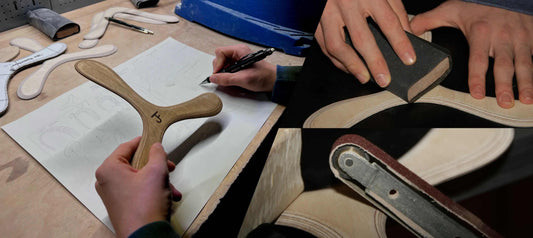
How to throw a boomerang correctly – a simple guide for beginners (with tips from a pro)
Share
The fascination of boomerangs – when wood flies and returns
A well-thrown boomerang is more than just a piece of wood – it is precision, physics and craftsmanship in motion.
But anyone who throws a boomerang for the first time knows the problem: It flies beautifully – but rarely back.
To make your boomerang truly return to you, you need the right technique , the right model , and a bit of a feel for wind and angle .
In this article, we'll show you step by step how to throw a boomerang correctly – so that it flies reliably and lands safely.
✋ 1. The right posture – how to get started
The perfect throw begins with the right grip.
Hold the boomerang so that the unpolished back side faces away from you, and thus the side with the logo faces you.
Grab the wing at the end , not in the middle.
👉 Tip: The boomerang should wobble slightly when thrown, but remain stable in your hand. Too tight a grip = an unclean throw.
Important:
Boomerangs are specially made for right-handed and left-handed people.
A right-handed boomerang is thrown with the right hand (rotation to the left),
A left-handed boomerang with the left hand (rotating to the right). You can find more information about the differences in our blog article.
🎯 2. The correct throwing angle – the secret to the return flight
The throwing angle is one of the most common sources of error – and at the same time the key to a perfect return flight.
📐 Here's how to find the optimal angle:
- Hold the boomerang vertically and slightly tilted to the right , about 10–20° from the vertical .
- Too steep (vertical) → the boomerang rises too sharply and loses energy.
- Too shallow (horizontal) → it falls to the ground before it can return.
👉 Remember: The boomerang doesn't fly over you, but in a large arc in front of you – so aim slightly in front of you, not at yourself.
A common beginner mistake:
Many people unconsciously rotate their wrist when throwing the ball, which changes the angle.
Keep your wrist stable throughout the entire throw to create a clean trajectory.
💨 3. Wind direction – your invisible playing partner
The wind will determine whether your throw is successful.
Anyone who simply throws "anywhere" will quickly wonder why the boomerang flies uncontrollably.
✅ Here's how to make the most of the wind:
- Stand facing directly into the wind .
- Throw the boomerang approximately 45° to the right against the wind (for right-handed people).
- For left-handed people, turn 45° to the left .
- If there is no wind , you can throw a little harder so that the boomerang gets enough energy.
👉 Mini trick:
Throw a few blades of grass into the air – they will immediately show you where the wind is coming from.
🔄 4. The throwing motion – rotation instead of force
A common misconception: Many people try to "throw the boomerang far" using only muscle power.
But what he needs is rotation , not force.
Here's how to throw correctly:
- Stand relaxed with one leg slightly forward.
- Return your arm as if you were throwing a javelin.
- Accelerate the boomerang with a quick, fluid forward motion.
- Give it a strong rotational impulse from the wrist when throwing it.
The boomerang should make a clean "whirring" sound when it flies – that's a good sign for enough rotation.
💡 Tip:
Practice the wrist movement first without the boomerang to get a feel for the torque.
🪶 5. Catching technique – safe & elegant
If everything goes well, your boomerang will come back to you in a wide arc.
Now the rule is: Don't panic, stay focused .
- Observe the trajectory – the boomerang will descend slightly at the end.
- Catch it by clapping it with both hands between your palms, not with one.
- Alternatively: Let it slide gently onto the floor if you are unsure.
Safety always comes first. It's best to wear gloves at first and practice in a large, open field.
⚙️ 6. Typical mistakes and how to avoid them
| Mistake | Caused | Solution |
| Boomerang rises too high and falls. | Too steep a throwing angle | Keep the angle slightly shallower |
| Boomerang flies too low and lands quickly | horizontal position | slightly upright (10–20°) |
| No return flight | Thrown by the wind or with insufficient rotation | against the wind + strong rotational momentum |
| Unstable flight | The wrist moves during the throw | Hold wrist firmly |
| Boomerang falls to the ground | Too weak a throw | throw more forcefully from the wrist |
🪵 7. The right material – why wood matters
Even the best technology is of little use if the material is poor.
Many cheap models made of plastic or thin plywood are not aerodynamically balanced – they simply cannot fly back cleanly due to physical limitations.
👉 Handcrafted wooden boomerangs , like those at JF Boomerang Manufactured in Munich, they are precisely ground, perfectly weighted and optimized for return flight.
They are ideal for beginners and advanced users and are made from sustainable wood.
🚀 Conclusion: Practice, patience & the right boomerang
Throwing a boomerang is not magic – it's a combination of technique, feeling, and patience.
If you master posture, throwing angle, wind direction and rotation, you will quickly notice how your boomerang returns to you in an elegant curve.
And with a high-quality model, e.g. from the father-son manufactory JF Bumerang , throwing is not only more fun – it actually works.

 https://www.jfbumerang.de
https://www.jfbumerang.de


